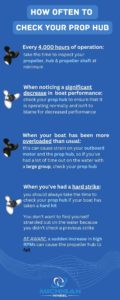Blogs
Between your motor’s prop shaft and inner prop hub is a location on your boat that can dramatically impact the performance you’ll get out of it. Because of the extreme torque that takes place at this location, it’s a common area for wear and failure in your boat, commonly referred to as a spun propeller, spun prop hub, or a spun bushing.
Whether you’re just trying to learn a bit more about your boat, or perhaps your prop shop threw this term at you and you want to make sure they’re not taking you for a ride by offering to put a new hub in your motor, in this article we’ll look over what a propeller hub is, what it does on your engine’s lower unit, what causes a spun prop, and how to fix the problem. We’ll also get into how it can impact your motor’s performance, requiring a higher RPM for the same performance as you used to get, and at what point you’ll want to get a new prop for your boat.
What is a Spun Prop?
A spun prop means that the propeller is no longer being turned by the engine because the prop hub has failed. In order to further understand what a spun prop is, let’s dive into what a prop hub is.
A propeller hub is a solid cylinder located at the center of the propeller, bored to accommodate the shaft. These come in 3 different shapes: cylindrical, conical, and barreled. A good prop hub, regardless of shape, should keep the propeller centered on the prop shaft, dampen vibrations, and help protect the shaft from the shock of striking an object with the propeller.
It’s important to note that there are two main types of hubs: pressed (bushing) and exchangeable, and each propeller is designed to use one or the other. Between the two hub types, there are a couple of key differences.
The first difference is material type — pressed hubs are made of rubber, while interchangeable hubs are often made of a more firm material.
Another key difference is that pressed hubs are forced into position by a high powered press in a prop shop, while an interchangeable hub can easily be inserted and doesn’t require a professional.
Regardless of these differences, both types of hubs serve as a shock absorber between the propeller and the prop shaft.
What Causes a Spun Prop?
Though most individuals consider themselves to be good sailors and caretakers of their boats, one of the biggest causes of a spun prop is the tendency to drop your boat to full throttle, taking it through a high acceleration curve of high engine RPM that puts a lot of torque on your prop hub. Another big reason for a spun prop is if your propeller takes a violent blow. When a prop forcefully collides with something while it is functioning, this abrupt stop causes its hub to wear out. In this situation, you can think of this much like a breaker popping on a power strip; the hub gives way to save your engine and drive shaft.
When a prop is spun, the drive shaft spins freely in the now broken or worn prop hub, so the power that it’s trying to deliver simply doesn’t transfer to the propeller.
Signs you may have a Spun Prop
When a prop has spun there are key warning signs you can look for to more easily identify and address the problem.
These signs can include:
- suddenly taking longer, or failing, to reach plane
- reduced speed and power at higher RPMs
- poor acceleration & performance
- poor fuel efficiency
- excessive vibration
Sometimes it’s obvious because you know that you’ve had a prop blade strike a hard object so these warning signs pop up right away. But general wear & tear may not be quite so obvious and it’s up to you to keep these warning signs in mind. The best way to catch a spun propeller before it gets bad or causes more damage to your motor’s lower unit is by undertaking an inspection at your local prop shop.
How to Diagnose a Spun Prop
To tell if your prop hub has spun, first mark a line on the front of the propeller and the propeller hub, directly across from one another with a marker. Next, run the propeller for 2-3 minutes and then shut it off. Lastly, you’ll inspect the two marks you previously made to see if they are still lined up to one another. If they aren’t, then the hub is spun.
How to Fix a Spun Prop
To determine what you need to do to fix your spun prop, you’ll need to start by undertaking a thorough inspection of the prop, drive shaft, and other components. If you pull your boat propeller off and find that the hub is torn up, you’ll need to replace the hub, but only if the rest of the propeller is still in good shape.
If your prop takes an exchangeable hub this is relatively easy and inexpensive. However, if you have a pressed-in hub or bushing then replacing it is not a DIY project. You’ll want to go to your local prop shop to have the work done, where they have the appropriate equipment to undertake replacement, as it requires pressing out your current bushing, and replacing it with a new one. Typical replacement costs anywhere from $50-100, depending on your engine and the shop you go to.
How Often to Check Your Prop Hub
It is important to take the time to inspect your propeller, hub and drive shaft at least every 4,000 hours of operation. At a minimum, if your prop slips around the drive shaft without the shaft turning, you know that you’ll need to undertake some repairs before getting out on the water again.
Similarly, if you notice that you have had a significant decrease in normal performance, you should take the time to check your prop hub, so that you can ensure that it is operating optimally. If your boat is more overloaded than usual, this can also cause strain on your outboard motor and the prop hub, so if you’ve had a lot of time on the lake with your family and friends this summer, take the time and give your prop the appropriate attention it needs to continue to run smoothly and efficiently.
Finally, if you have had a hard strike, even if you think it’s okay, you should take the time to check your prop hub. You don’t want to find yourself stranded out on the water because you didn’t check that hard hit you took last week, even if you think it’s been mostly fine since then. A sudden increase in high RPMs can cause the propeller hub to fully fail.
Stay Prepared on the Water with Michigan Wheel!
Much like keeping a spare spark plug in the glove-box, an extra can of gas in the trailer, or a solar battery charger in your back-pack, having a spare prop and hub kit can help you get out of troubled waters.
Whether you’re replacing your prop, or just want a durable spare, for a high-quality propeller you can trust, shop Michigan Wheel.







